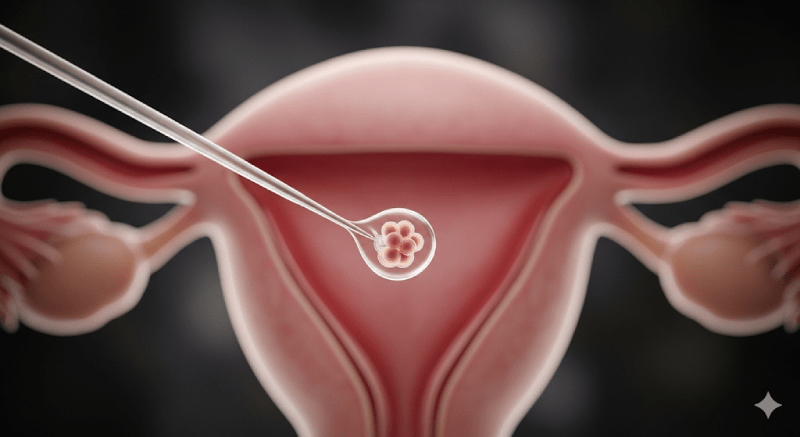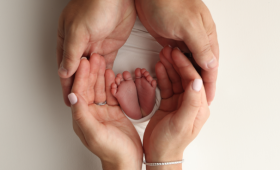The Critical Threshold After Egg Retrieval – A Turning Point in the Journey to Pregnancy
In vitro fertilization (IVF) treatment represents an intense experience for couples, both physically and emotionally, where hope and uncertainty intertwine. The fundamental building blocks of this treatment consist of hormonal stimulation, egg retrieval (ovum pick-up, OPU), and the embryo transfer stages. Among these three phases, the egg retrieval procedure stands out as the most critical step requiring surgical intervention. This stage is not only a physiological turning point but also prepares patients for the most sensitive and uncertain subsequent phase of the treatment, namely the period leading up to embryo transfer and the pregnancy test.
The primary purpose of this report is to holistically examine the process that occurs after the egg retrieval procedure. Our goal is not limited to merely explaining the medical procedures and expected physiological reactions; we also aim to provide in-depth guidance on all types of physiological, psychological, and logistical challenges that may be encountered during this delicate period. The report aims to cover every detail, from common symptoms to rare complications, from embryo transfer decisions to managing the waiting period, with the goal of providing couples on their IVF journey with the necessary information to take informed and safe steps.
The Egg Retrieval (OPU) Procedure and Immediate Aftermath
General Outlines of the Egg Retrieval Procedure
Egg retrieval is the process of collecting egg cells that have reached a certain maturity and size from the body using hormonal injections. This procedure is performed approximately 34-36 hours after a trigger shot (hCG) is administered, when the eggs have completed their final maturation and are ready to be collected. The procedure, which usually takes 20-30 minutes, is performed in a sterile operating room under light sedation or general anesthesia. This ensures that the patient does not feel any pain or discomfort during the procedure.
The procedure is performed under the guidance of a vaginal ultrasound, using a special, thin needle that provides negative pressure. The follicles are individually visualized on the ultrasound screen, and the mature eggs inside are collected with the help of this needle. The collected eggs are examined by embryologists in a laboratory setting. This examination provides the initial information about the quality and quantity of the eggs. Although the number of eggs varies from person to person, it can range from 1 to 35, and 8-10 eggs are considered an ideal number.
The First 24 Hours Post-Procedure: Rest and Observation
After the egg retrieval procedure is completed, the patient is kept under observation for about 1-2 hours for bleeding control and until the effects of the anesthesia wear off. Following this short observation period, the patient is discharged. Experts strongly recommend that this first day be spent entirely resting. This period of rest is of critical importance for the body to recover from the effects of anesthesia and to release the physiological stress caused by the procedure. Additionally, considering the rare possibility of complications after the procedure, having a companion with the prospective mother can help make this process safer and more comfortable.
Beginning of the Recovery Process
The post-procedure recovery process usually takes 1-2 days. During this period, the body attempts to cope with both the physical effects of the egg retrieval procedure and hormonal fluctuations. Due to hormonal stimulation, the ovaries can swell up to three times their normal size, which can lead to pain in the groin area. This pain is a natural reaction of the body and does not contradict the pain-free experience felt during the procedure itself. Anesthesia prevents pain during the surgical intervention, while the body’s reactions to the operation afterward are an entirely physiological process. The discomfort felt during this period is at a level that can be managed with simple painkillers. Along with the physical dimension of the recovery process, it is of great importance for patients to view this period as a transition to the next critical stage, the embryo transfer, in order to manage the process holistically.
Physical Symptoms and Management
Common and Normal Symptoms
After the egg retrieval procedure, most patients experience some symptoms that are generally not a cause for concern. The most common of these symptoms are abdominal pain and cramping. This pain is usually of a mild intensity, similar to menstrual cramps, and may last for a few days. In most cases, this pain can be easily alleviated with paracetamol-based painkillers recommended by the doctor.
Another common symptom is vaginal spotting or light bleeding. Since the egg retrieval procedure is performed vaginally and a thin needle is used to access the ovaries, it is normal to see light bleeding or spotting from the needle entry points. This bleeding is usually dark red or brown and stops on its own within a few days.
Bloating and gas pain in the lower abdomen are also frequently encountered symptoms. This condition may persist for a few days but is not a cause for panic. Avoiding gas-producing foods before the procedure can help reduce the severity of these symptoms.
Nutrition and Hydration
Paying attention to nutrition and fluid intake is vital to support the recovery process after egg retrieval. Drinking plenty of water is a strategic action to help manage fluid imbalances that may arise due to hormonal fluctuations and to reduce the risk of Ovarian Hyperstimulation Syndrome (OHSS), in addition to speeding up overall recovery. This is more than a simple piece of advice; it’s a strategic action aimed at preventing a potential complication.
As for the diet, if nausea or vomiting occurs due to anesthesia, light foods (tea, biscuits) that won’t strain the stomach should be preferred, and fatty and spicy foods should be avoided. If there is no nausea, a protein-rich diet (chicken, fish, yogurt) with fresh vegetables and fruits is recommended. It is important to limit salt intake to reduce bloating. Furthermore, harmful substances like cigarettes and alcohol should be avoided, as these substances negatively affect embryo quality.
Physical Activity and Sexual Abstinence
Excessive physical activity should be avoided after the egg retrieval procedure. Especially in the first few days, strenuous exercises, running, or sudden movements are not recommended. Instead, light-paced walks, relaxation exercises, or body-friendly activities like yoga support both blood circulation and help maintain mental balance. Scientific views that long-term bed rest should be avoided aim not only to promote physical recovery but also to prevent immobility that can increase anxiety and stress.
Since the ovaries are more sensitive and enlarged than usual, it is advisable to refrain from sexual intercourse for a while to minimize the risk of infection and avoid causing pain. Various sources recommend this period of abstinence to last between 5-7 days and 2 weeks. This precaution is a medical necessity aimed at reducing vaginal sensitivity and preventing potential sources of infection.
Table 1: Common Post-Egg Retrieval Symptoms and Their Management
| Symptom | Description | Typical Duration | Management | When to Contact Your Doctor? |
| Mild Abdominal Pain and Cramping | Pain similar to menstrual cramps, caused by the collection of follicles and ovarian enlargement. | A few days | Paracetamol-based painkillers, rest, hot compress. | If the intensity gradually increases and does not respond to painkillers. |
| Vaginal Bleeding/Spotting | Light, dark-colored bleeding from the needle entry points. | A few days | Use pads, avoid tampons. | If the bleeding becomes excessive, red, and continuous. |
| Gas Pain and Bloating | Discomfort and a feeling of tightness in the lower abdomen. | A few days | Avoid gas-producing foods, drink plenty of water, take light walks. | If it reaches severe and discomforting levels. |
| Nausea and Vomiting | May occur due to anesthesia. | The first 24-48 hours | Non-fatty and non-spicy foods, tea, biscuits. | If symptoms become continuous and severe. |
Potential Complications and Emergencies
Although the egg retrieval procedure is generally a safe process, some complications can rarely occur. Being aware of these situations prevents patients from experiencing unnecessary anxiety and allows them to take the right steps in situations requiring emergency intervention.
Ovarian Hyperstimulation Syndrome (OHSS)
Ovarian Hyperstimulation Syndrome (OHSS) is a condition that occurs when the body overreacts to the hormonal medications used to enlarge the ovaries. This is the most common complication in IVF treatment and is more frequently seen in young women or patients who have a large number of eggs develop. Symptoms, which begin 4-5 days after the egg retrieval procedure, include nausea, vomiting, diarrhea, abdominal bloating, rapid weight gain, difficulty breathing, and a decrease in the amount of urine.
While obtaining a large number of eggs increases the success of the treatment, it also raises the risk of OHSS. In such cases, a strategic decision is made to freeze the embryos instead of performing a fresh embryo transfer, and to postpone the transfer until the next menstrual cycle. This allows the elevated hormone levels to return to normal, eliminating this risk. This clearly demonstrates how a single physiological condition (excessive egg development) can change the entire treatment plan and highlights the importance given to risk management in modern IVF treatment.
Severe Bleeding and Infection
Severe bleeding and infections after the procedure are rare complications, but they are possible. The needle used during the egg retrieval procedure can cause minor bleeding in the vaginal tissues or pelvic vessels, but this bleeding usually stops on its own and does not require intervention.
To minimize the risk of infection, it is mandatory to use antibiotics after the procedure. Furthermore, paying attention to personal hygiene rules further reduces the risk of infection. Conditions like endometriosis can also rarely increase the risk of infection. Although injury to abdominal organs such as the bladder or intestines during the procedure is very rare, the physician’s expertise and experience play a key role in minimizing such risks.
Table 2: Emergency Warning Signs and Actions
| Signal | Potential Cause | Action to be Taken |
| Severe and Increasing Abdominal Pain | Ovarian torsion (the ovary twisting on itself) or internal bleeding. | Immediately contact your doctor or the emergency room. |
| Excessive Vaginal Bleeding | Bleeding that soaks through underwear continuously or is as heavy as a menstrual period, beyond normal spotting. | Immediately contact the clinic where the procedure was performed. |
| Body Temperature Rises Above 38°C (100.4°F) | Could be a sign of infection. | Immediately inform your doctor. |
| Decreased Urine Output or Blood in Urine | OHSS or bladder injury. | Seek emergency medical attention. |
| Persistent Nausea, Vomiting, and Rapid Weight Gain | A symptom of OHSS, fluid accumulation in the body. | Inform your doctor and follow their recommendations. |
Preparing for Embryo Transfer: Fresh or Frozen?
After the egg retrieval procedure, the preparation process for the next critical stage of the treatment, the embryo transfer, begins. This process involves placing the fertilized eggs (embryos) into the uterus in a laboratory setting, and the success of this stage depends on a complex set of factors.
Embryo Quality and Assessment
Embryo quality is one of the most important factors directly affecting the success of IVF treatment. High-quality embryos have a higher potential for implantation in the uterus and for establishing a healthy pregnancy. Embryo quality is assessed by embryologists in the laboratory based on morphological characteristics such as cellular structure, cleavage rate, minimal fragmentation (fragmented structures within the cell cytoplasm), and cell symmetry. International classification systems are used for this assessment; for example, codes like
5BB or 3AA provide information about the embryo’s developmental stage and quality.
The main factors affecting embryo quality include maternal age, genetic factors, the overall health of the prospective mother and father, and the laboratory conditions used for the embryo development process. The advancing age of the mother, in particular, leads to a significant decrease in egg quality, which negatively affects embryo quality.

Comparison of Fresh and Frozen Embryo Transfer
Embryo transfer can be performed at different stages after egg retrieval, such as on day 2 (4-cell), day 3 (8-cell), or day 5 (blastocyst). This transfer is divided into “fresh” or “frozen” transfer depending on whether the embryo is frozen.
Fresh Embryo Transfer is performed immediately after the egg retrieval procedure, usually within 3-5 days. The biggest advantage of this method is that the embryos are not affected by the freezing and thawing process. However, due to the hormonal stimulation process, the uterine environment (endometrium) of the prospective mother may sometimes not be optimal for transfer, which can reduce the chance of implantation.
Frozen Embryo Transfer (FET) involves preserving embryos using a rapid freezing technique called vitrification. The most important advantage of this method is that it allows the uterine environment to be prepared to be ideal for transfer. Frozen transfer can offer higher success rates in some cases compared to fresh transfer, as the uterine environment is prepared independently of the hormonal stimulation process.
Frozen transfer is preferred in special circumstances such as:
- OHSS Risk: In patients at risk for OHSS due to a large number of eggs developing, the transfer is postponed to eliminate the risk.
- Inadequate Uterine Lining Development: If the uterine lining does not reach sufficient thickness despite egg development, the embryos are frozen and transferred in a subsequent menstrual cycle.
- Genetic Analysis: If preimplantation genetic testing (PGT) is to be performed, the embryos must be frozen while waiting for the results to come out.
In terms of procedure technique, there is no difference between fresh and frozen transfer; both are performed under ultrasound guidance, with the embryo being placed into the uterus via a catheter.
Table 3: Comparison of Fresh and Frozen Embryo Transfer
| Comparison Criterion | Fresh Embryo Transfer | Frozen Embryo Transfer (FET) |
| Timing | Within 3-5 days after egg retrieval. | When the ideal uterine environment is ready, usually in a subsequent cycle. |
| Uterine Environment | May not be optimal due to hormonal stimulation. | Ideal because it is prepared specifically for transfer, independent of hormonal stimulation. |
| Risk Management | Not preferred in patients with a high risk of OHSS. | Eliminates the risk of OHSS. |
| Flexibility | Timing is limited. | Makes the treatment process more flexible. |
| Advantages | Not affected by the freezing-thawing process. | Potentially higher success rates, a better uterine environment. |
| Disadvantages | The possibility of the uterine environment not being optimal. | The freezing and thawing process can affect the viability of the embryo (rarely). |
Embryo Transfer and The Post-Procedure Process
The Embryo Transfer Procedure
Embryo transfer is the most important and final step of IVF treatment. This procedure is a painless and easy application that does not require anesthesia. The patient is positioned for a gynecological examination, and under ultrasound guidance, one or two high-quality embryos brought from the laboratory in a special catheter are placed into the uterus. After the procedure is completed, the patient is usually rested for a short period and can then return to her normal daily life.
Post-Transfer Myths and Facts
Many misconceptions and myths after embryo transfer cause unnecessary stress for patients. The most prominent of these is the need for prolonged bed rest. Scientific data indicates that prolonged bed rest after transfer does not increase pregnancy rates and can even have negative effects by increasing stress. A short rest is sufficient to rest the body and mind. On the contrary, activities such as light-paced walking provide a healthier process both physically and psychologically by supporting blood circulation and maintaining mental balance. If there is no stressful or dangerous work environment, returning to daily routines and work life can make the patient feel happier and less anxious.
The Critical Period Until the Pregnancy Test: “The Two-Week Wait”
The approximately 10-12 day period between embryo transfer and the pregnancy test is the most stressful and uncertain stage of IVF treatment. This period, known as the “two-week wait,” is a psychological test where intense emotions such as hope, anxiety, worry, and impatience are experienced together.
Emotional and Psychological Preparation
IVF treatment is a psychologically challenging process for both the prospective mother and father. The fact that the physiological burden is largely on the woman can cause her to be more psychologically affected. The emotional support, open communication, and empathy that partners provide to each other during this period are extremely important. High levels of stress are a factor that can negatively affect pregnancy rates. Therefore, stress management is not just a method of emotional relief but also a critical factor with biological consequences for the success of the treatment.
Psychological Support and Coping Mechanisms
There are various ways to cope with this period of uncertainty. Couples who cannot cope with anxiety or depression are advised to seek professional support from a specialized psychologist. Psychological counseling helps couples manage the process better, acquire skills to cope with emotional difficulties, and provide more support to each other.
Activities that keep the mind occupied and distract can also make this process easier. Hobbies such as reading books, crafts, yoga, meditation, or light exercise can be effective in reducing stress and improving mood. Furthermore, sharing this process with as few people as possible or not at all can reduce stress by preventing unnecessary pressure and expectations from the outside. Most importantly, avoiding prolonged immobility, which can increase stress, and returning to daily routines and seeking social support in environments where you feel safe can be of great benefit.
Key Factors Affecting IVF Success
The success of IVF treatment is determined by the combination of many factors, along with the correct management of the post-egg retrieval process. These factors include both biological and environmental elements.
General Factors
- Maternal Age: The most important factor affecting the success of IVF treatment is the age of the prospective mother. As age advances, the number and quality of eggs decrease significantly, which reduces pregnancy rates.
- Egg Count and Quality: The number and quality of eggs obtained as a result of the egg retrieval procedure have a direct effect on the success of the treatment. Ideally, reaching a number of 8-10 eggs is a factor that increases treatment success.
- Genetic Factors: The genetic material from the prospective mother and father is another important factor affecting embryo quality and thus the chance of implantation.
The Role of Clinic and Laboratory Quality
Treatment success does not only depend on patient-specific biological factors. The experience of the team conducting the treatment and the laboratory conditions of the clinic also play a critical role. The physician’s experience is effective in preventing complications that may arise during the procedure, while modern laboratory conditions increase the chance of success by preserving embryo quality and making accurate assessments. This demonstrates how important it is for patients to also consider the physician’s and laboratory’s experience when choosing a treatment center.
The Value of a Hope-Filled Journey
The process after egg retrieval is not just a medical stage of IVF treatment, but also a multi-layered journey that tests physical and psychological resilience. Knowing that the physiological reactions that can be experienced during this critical period (pain, bloating, bleeding) are normal and being able to distinguish situations that require emergency intervention allows patients to manage the process in a safer and more controlled manner.
The decision for embryo transfer is a strategic choice between fresh or frozen transfer, based on factors such as embryo quality and the state of the uterine environment. Understanding the scientific rationale behind this decision increases patients’ confidence in the treatment. This process also highlights the importance of moving away from scientifically unfounded myths like “prolonged bed rest” and turning to evidence-based, accurate information.
Finally, the success of this journey is not limited to the excellence of the medical procedures. Personal management factors such as stress management, proper nutrition, light physical activity, and partner support positively affect the success of the treatment with a holistic approach. Taking conscious and evidence-based steps in this difficult but hope-filled process will allow patients to feel more in control of their own health and future, and will help them complete this journey more strongly.



